There are many trigger points that can send pain to the lateral epicondyle of the elbow.
Treatment of the two most common tennis elbow trigger points will be discussed.
Contents, this page
- What is a trigger point?
- Extensor Carpi Radialis Longus Massage
- Extensor Digitorum Massage
(What is a trigger point?)
- (Show/Hide)
Think of a trigger point as a small and incredibly persistent cramp in the muscle -
We have all had painful moments when a large section in the
body of a muscle has contracted and then not released. Fortunately, these tend to release if we
immediately lengthen the muscle. A trigger point is just a smaller version of this cramp.
Trigger points can be felt in muscles as firm knots
varying in size from that of a pinhead to that of your thumb or even larger.
They may go undetected for months or years, but nevertheless cause pain and discomfort. Usually the pain is felt
at the ends of the muscle where it attaches to the bone. When you press on a trigger point with your thumb,
the pain is sharp (to say the least!). When you hold that pressure for
half a minute or so (a procedure called "trigger point massage"), the trigger point "switches off".
In summary, trigger points are knots in the muscle and are caused by muscle overuse. They can
be switched off by direct pressure with a thumb or tennis ball.
See:-
Biology of Trigger Points
h_TriggerPoints
Return to top
Massage of the Extensor Carpi Radialis Longus Muscle
Trigger points in the extensor carpi radialis longus are a very common cause of tennis
elbow pain, and can readily be de-activated by the method detailed below.
Action of the Extensor Carpi Radialis Longus Muscle
The Extensor Carpi Radialis Longus (ECRL) bends the wrist toward the
thumb side of the hand and also backwards. It also helps bend the elbow.
These three actions are demonstrated in picture 1. You would for example use
this action when throwing a Frisbee.
When this or any muscle is worked hard, it develops trigger points.
Common activities that work this muscle hard are key board typing, and computer mouse
work (especially when the mouse is held too far to the side of the key board).
A more complete list of activities that may cause trigger points and tennis
elbow pain are shown in the panel below.
(Show/Hide)
List of activities that work the Extensor carpi radialis:-
- Typing
- Piano playing
- Computer mouse work
- Tennis and Golf
- Stirring paint or cookie doug
h
- Screw driver work.
|
|
|
Picture 1: The wrist and arm action that works the Extensor carpi radialis longus muscle.
The opposite hand is in position to feel the muscle go tense.

|
How to Locate the Trigger Point in the Extensor Carpi Radialis Longus Muscle
The trigger point in the extensor carpi radialis is about two inches away from the crease of the
elbow. Locate it thus:
- Bend the elbow up and with the other hand hold the forearm close to the elbow (refer picture 1 above).
- Extend the wrist (fist moves away from you), and lower the outstretched thumb.
(The muscle is now tense under your finger tips).
- Explore the tense muscle by pressing into it with the tip of the second finger.
Trigger points in muscles are painful when pressed - you will have no trouble finding this one!
|
|
Diagram 1: Extensor carpi radialis longus trigger point and referred pain pattern
(the drawings show the outer side of the forearm and hand).
Left: The muscle together with its trigger point.
Right: the trigger point location and its pain referral patterns.
(From Clair Davies:
The Trigger Point Therapy Workbook).
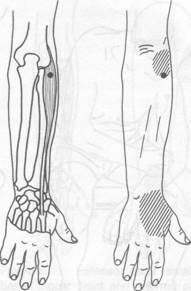
|
How to De-activate the Trigger Point in the Extensor Carpi Radialis Longus Muscle
- Relax the wrist and thumb, and press into the sore spot for 6 to 30 seconds.
- Work to the limit of your pain. Be patient. Repeat once if necessary (see picture 2).
- Follow up by stretching the muscle (see picture 3).
How often? -
Repeat twice weekly, or (if you keep the pressure light) as often as you feel you need it.
Note: You could attempt to press on the ECRL trigger point with the elbow not
bent, but in this position, the ECRL muscle just roles around the bone and hides
under its neighbor, the Brachioradialis muscle.
|
|
Picture 2: The right arm is now relaxed, and the middle finger of the opposite hand
is pressing on the trigger point that has just been located -it's painful,
but the result will be worth it!

Picture 3: Extensor Carpi Radialis Longus Stretch
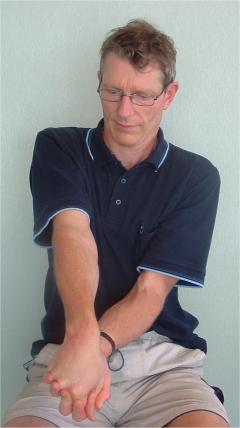
|
Return to top
Extensor Digitorum Massage
Trigger points in the extensor digitorum are also a major cause of tennis elbow pain.
The extensor digitorum straightens (extends) the third, fourth, and fifth fingers.
Trigger points in the extensor digitorum send pain to the outer elbow, and the
second knuckle of the third and fourth fingers.
When you make a fist or grasp something strongly, the finger extensors are
called upon to help keep the wrist from bending when the fingers bend. The
harder you grip something, the harder the finger extensors have to work.
List of activities that work the Extensor carpi radialis hard:-
- Computer keyboarding
- Computer mouse work (make sure you take your hand off the mouse as often as you possibly can!)
- Gripping a tennis racket
|
|
Diagram 2: Extensor digitorum -
trigger point and referred pain pattern
(Source: The Trigger Point Therapy Workbook).
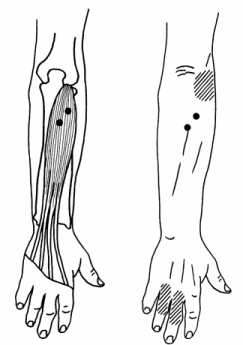
|
How to Locate the Trigger Points in the Extensor digitorum Muscle
There are two trigger points in the Extensor digitorum muscle; both of which are
associated with the hard working middle finger. (It is rare for the third and
fourth fingers to be working hard enough to cause trouble in the extensor digitorum muscle).
Here is how to locate them:
First Trigger Point (see pictures 4 and 5)):
Locate the first trigger point by pressing the fingers into the muscle about 2
inches away from the crease of the elbow, and waggling the middle finger.
This action tenses and relaxes the ED muscle so you know where it is, and you can then search for
the painful spot in the muscle.
Second Trigger Point
The instructions are the same as for the first trigger point, just place the
fingers about 2 and three quarter inches away from from the crease of the elbow.
How to De-activate the Trigger Points in the Extensor digitorum Muscle
- Press into the trigger point with the middle finger (the other fingers aid
the middle finger by stabilizing the Extensor muscle)
- Six to 30 seconds at the
pain level you can easily tolerate, and then repeat once if necessary.
- Follow up by stretching the muscle (see pictures 5 and 6).
Repeat twice weekly, or (if you keep the pressure light) as often as you feel you need it.
Summary
You have now learnt to de-activate trigger points in two of the most common locations in
the forearm. For many people, de-activating these trigger points will be enough to bring
about relief to their trigger point induced tennis elbow problem. There are however many
more trigger points that may be involved. Both in the forearm, and higher up the arm,
shoulder and even the neck. This excellent book will help you:
Trigger Point Book Recommendation
Read what people have to say about this remarkable book! -
Clair Davies:
The Trigger Point Therapy Workbook.
|
|
Picture 4: By applying finger tips across the body of the Extensor digitorum muscle,
we can minimise side role of the muscle and keep it securely under the pressure of the middle finger
(note: next picture shows actual hand positioning
to press on the trigger point)...

Picture 5: Locate the muscle by waggling the middle finger,
and then probe for and de-activate the sore spots with the middle finger. The first and third
fingers are there to minimise the side roll of the extensor digitorum muscle .
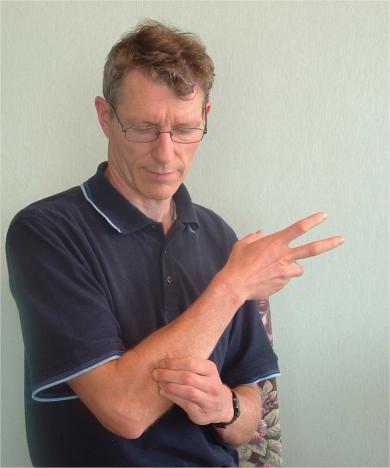
Picture 6: To stretch the extensor digitorum longus, make a fist and curl it
downward with the help of the other hand.
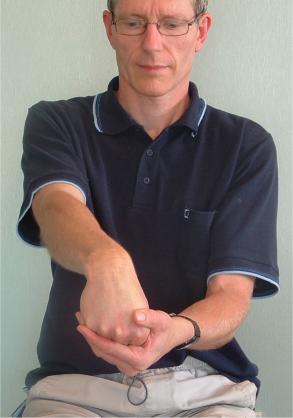
|
Return to top
© Bruce Thomson, EasyVigour Project
| OBP. together with trigger point massage brings a totally new and safe approach
to cures for tennis elbow and other repetitive strain injuries.
Try comparing what you have just learned with what is available online!- |
|
Cures Tennis Elbow
|

Return to top...
Tennis elbow treatment: trigger point massage
© Bruce Thomson, EasyVigour Project

|
|
Trigger Point Book Recommendation
Read what people have to say about this remarkable book! -
Clair Davies:
The Trigger Point Therapy Workbook.
|